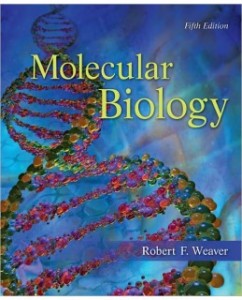Test Bank for Molecular Biology, 5th Edition: Robert Weaver
$35.00 Original price was: $35.00.$26.50Current price is: $26.50.
Test Bank for Molecular Biology, 5th Edition: Robert Weaver
This is completed downloadable of Test Bank for Molecular Biology, 5th Edition: Robert Weaver

Product Details:
- ISBN-10 : 0073525324
- ISBN-13 : 978-0073525327
- Author: Robert Weaver
Molecular Biology, 5/e by Robert Weaver, is designed for an introductory course in molecular biology. Molecular Biology 5/e focuses on the fundamental concepts of molecular biology emphasizing experimentation. In particular author, Rob Weaver, focuses on the study of genes and their activities at the molecular level. Through the combination of excellent illustrations and clear, succinct writing students are presented fundamental molecular biology concepts.
Table of Content:
- PART I Introduction
- CHAPTER 1 A Brief History
- 1.1 Transmission Genetics
- Mendel’s Laws of Inheritance
- The Chromosome Theory of Inheritance
- Genetic Recombination and Mapping
- Physical Evidence for Recombination
- 1.2 Molecular Genetics
- The Discovery of DNA
- The Relationship Between Genes and Proteins
- Activities of Genes
- 1.3 The Three Domains of Life
- CHAPTER 2 The Molecular Nature of Genes
- 2.1 The Nature of Genetic Material
- Transformation in Bacteria
- The Chemical Nature of Polynucleotides
- 2.2 DNA Structure
- Experimental Background
- The Double Helix
- 2.3 Genes Made of RNA
- 2.4 Physical Chemistry of Nucleic Acids
- A Variety of DNA Structures
- DNAs of Various Sizes and Shapes
- CHAPTER 3 An Introduction to Gene Function
- 3.1 Storing Information
- Overview of Gene Expression
- Protein Structure
- Protein Function
- Discovery of Messenger RNA
- Transcription
- Translation
- 3.2 Replication
- 3.3 Mutations
- Sickle Cell Disease
- PART II Methods of Molecular Biology
- CHAPTER 4 Molecular Cloning Methods
- 4.1 Gene Cloning
- The Role of Restriction Endonucleases
- Vectors
- Identifying a Specific Clone with a Specific Probe
- cDNA Cloning
- Rapid Amplification of cDNA Ends
- 4.2 The Polymerase Chain Reaction
- Standard PCR
- Box 4.1 Jurassic Park: More than a Fantasy?
- Using Reverse Transcriptase PCR (RT-PCR) in cDNA Cloning
- Real-Time PCR
- 4.3 Methods of Expressing Cloned Genes
- Expression Vectors
- Other Eukaryotic Vectors
- Using the Ti Plasmid to Transfer Genes to Plants
- CHAPTER 5 Molecular Tools for Studying Genes and Gene Activity
- 5.1 Molecular Separations
- Gel Electrophoresis
- Two-Dimensional Gel Electrophoresis
- Ion-Exchange Chromatography
- Gel Filtration Chromatography
- Affinity Chromatography
- 5.2 Labeled Tracers
- Autoradiography
- Phosphorimaging
- Liquid Scintillation Counting
- Nonradioactive Tracers
- 5.3 Using Nucleic Acid Hybridization
- Southern Blots: Identifying Specific DNA Fragments
- DNA Fingerprinting and DNA Typing
- Forensic Uses of DNA Fingerprinting and DNA Typing
- In Situ Hybridization: Locating Genes in Chromosomes
- Immunoblots (Western Blots)
- 5.4 DNA Sequencing and Physical Mapping
- The Sanger Chain-Termination Sequencing Method
- Automated DNA Sequencing
- High-Throughput Sequencing
- Restriction Mapping
- 5.5 Protein Engineering with Cloned Genes: Site-Directed Mutagenesis
- 5.6 Mapping and Quantifying Transcripts
- Northern Blots
- S1 Mapping
- Primer Extension
- Run-Off Transcription and G-Less Cassette Transcription
- 5.7 Measuring Transcription Rates in Vivo
- Nuclear Run-On Transcription
- Reporter Gene Transcription
- Measuring Protein Accumulation in Vivo
- 5.8 Assaying DNA–Protein Interactions
- Filter Binding
- Gel Mobility Shift
- DNase Footprinting
- DMS Footprinting and Other Footprinting Methods
- Chromatin Immunoprecipitation (ChIP)
- 5.9 Assaying Protein–Protein Interactions
- 5.10 Finding RNA Sequences That Interact with Other Molecules
- SELEX
- Functional SELEX
- 5.11 Knockouts and Transgenics
- Knockout Mice
- Transgenic Mice
- PART III Transcription in Bacteria
- CHAPTER 6 The Mechanism of Transcription in Bacteria
- 6.1 RNA Polymerase Structure
- Sigma (σ) as a Specificity Factor
- 6.2 Promoters
- Binding of RNA Polymerase to Promoters
- Promoter Structure
- 6.3 Transcription Initiation
- Sigma Stimulates Transcription Initiation
- Reuse of σ
- The Stochastic σ-Cycle Model
- Local DNA Melting at the Promoter
- Promoter Clearance
- Structure and Function of σ
- The Role of the α-Subunit in UP Element Recognition
- 6.4 Elongation
- Core Polymerase Functions in Elongation
- Structure of the Elongation Complex
- 6.5 Termination of Transcription
- Rho-Independent Termination
- Rho-Dependent Termination
- CHAPTER 7 Operons: Fine Control of Bacterial Transcription
- 7.1 The lac Operon
- Negative Control of the lac Operon
- Discovery of the Operon
- Repressor–Operator Interactions
- The Mechanism of Repression
- Positive Control of the lac Operon
- The Mechanism of CAP Action
- 7.2 The ara Operon
- The ara Operon Repression Loop
- Evidence for the ara Operon Repression Loop
- Autoregulation of araC
- 7.3 The trp Operon
- Tryptophan’s Role in Negative Control of the trp Operon
- Control of the trp Operon by Attenuation
- Defeating Attenuation
- 7.4 Riboswitches
- CHAPTER 8 Major Shifts in Bacterial Transcription
- 8.1 Sigma Factor Switching
- Phage Infection
- Sporulation
- Genes with Multiple Promoters
- Other σ Switches
- Anti-σ-Factors
- 8.2 The RNA Polymerase Encoded in Phage T7
- 8.3 Infection of E. coli by Phage λ
- Lytic Reproduction of Phage λ
- Establishing Lysogeny
- Autoregulation of the cI Gene During Lysogeny
- Determining the Fate of a λ Infection: Lysis or Lysogeny
- Lysogen Induction
- CHAPTER 9 DNA–Protein Interactions in Bacteria
- 9.1 The λ Family of Repressors
- Probing Binding Specificity by Site-Directed Mutagenesis
- Box 9.1 X-Ray Crystallography
- High-Resolution Analysis of λ Repressor–Operator Interactions
- High-Resolution Analysis of Phage 434 Repressor–Operator Interactions
- 9.2 The trp Repressor
- The Role of Tryptophan
- 9.3 General Considerations on Protein–DNA Interactions
- Hydrogen Bonding Capabilities of the Four Different Base Pairs
- The Importance of Multimeric DNA-Binding Proteins
- 9.4 DNA-Binding Proteins: Action at a Distance
- The gal Operon
- Duplicated λ Operators
- Enhancers
- PART IV Transcription in Eukaryotes
- CHAPTER 10 Eukaryotic RNA Polymerases and Their Promoters
- 10.1 Multiple Forms of Eukaryotic RNA Polymerase
- Separation of the Three Nuclear Polymerases
- The Roles of the Three RNA Polymerases
- RNA Polymerase Subunit Structures
- 10.2 Promoters
- Class II Promoters
- Class I Promoters
- Class III Promoters
- 10.3 Enhancers and Silencers
- Enhancers
- Silencers
- CHAPTER 11 General Transcription Factors in Eukaryotes
- 11.1 Class II Factors
- The Class II Preinitiation Complex
- Structure and Function of TFIID
- Structure and Function of TFIIB
- Structure and Function of TFIIH
- The Mediator Complex and the RNA Polymerase II Holoenzyme
- Elongation Factors
- 11.2 Class I Factors
- The Core-Binding Factor
- The UPE-Binding Factor
- Structure and Function of SL1
- 11.3 Class III Factors
- TFIIIA
- TFIIIB and C
- The Role of TBP
- CHAPTER 12 Transcription Activators in Eukaryotes
- 12.1 Categories of Activators
- DNA-Binding Domains
- Transcription-Activating Domains
- 12.2 Structures of the DNA-Binding Motifs of Activators
- Zinc Fingers
- The GAL4 Protein
- The Nuclear Receptors
- Homeodomains
- The bZIP and bHLH Domains
- 12.3 Independence of the Domains of Activators
- 12.4 Functions of Activators
- Recruitment of TFIID
- Recruitment of the Holoenzyme
- 12.5 Interaction Among Activators
- Dimerization
- Action at a Distance
- Box 12.1 Genomic Imprinting
- Transcription Factories
- Complex Enhancers
- Architectural Transcription Factors
- Enhanceosomes
- Insulators
- 12.6 Regulation of Transcription Factors
- Coactivators
- Activator Ubiquitylation
- Activator Sumoylation
- Activator Acetylation
- Signal Transduction Pathways
- CHAPTER 13 Chromatin Structure and Its Effects on Transcription
- 13.1 Chromatin Structure
- Histones
- Nucleosomes
- The 30-nm Fiber
- Higher-Order Chromatin Folding
- 13.3 Chromatin Structure and Gene Activity
- The Effects of Histones on Transcription of Class II Genes
- Nucleosome Positioning
- Histone Acetylation
- Histone Deacetylation
- Chromatin Remodeling
- Heterochromatin and Silencing
- Nucleosomes and Transcription Elongation
- PART V Post-Transcriptional Events
- CHAPTER 14 RNA Processing I: Splicing
- 14.1 Genes in Pieces
- Evidence for Split Genes
- RNA Splicing
- Splicing Signals
- Effect of Splicing on Gene Expression
- 14.2 The Mechanism of Splicing of Nuclear mRNA Precursors
- A Branched Intermediate
- A Signal at the Branch
- Spliceosomes
- Spliceosome Assembly and Function
- Commitment, Splice Site Selection, and Alternative Splicing
- Control of Splicing
- 14.3 Self-Splicing RNAs
- Group I Introns
- Group II Introns
- CHAPTER 15 RNA Processing II: Capping and Polyadenylation
- 15.1 Capping
- Cap Structure
- Cap Synthesis
- Functions of Caps
- 15.2 Polyadenylation
- Poly(A)
- Functions of Poly(A)
- Basic Mechanism of Polyadenylation
- Polyadenylation Signals
- Cleavage and Polyadenylation of a Pre-mRNA
- Poly(A) Polymerase
- Turnover of Poly(A)
- 15.3 Coordination of mRNA Processing Events
- Binding of the CTD of Rpb1 to mRNA-Processing Proteins
- Changes in Association of RNA-Processing Proteins with the CTD Correlate with Changes in CTD Phospho
- A CTD Code?
- Coupling Transcription Termination with mRNA 3′-End Processing
- Mechanism of Termination
- Role of Polyadenylation in mRNA Transport
- CHAPTER 16 Other RNA Processing Events and Post-Transcriptional Control of Gene Expression
- 16.1 Ribosomal RNA Processing
- Eukaryotic rRNA Processing
- Bacterial rRNA Processing
- 16.2 Transfer RNA Processing
- Cutting Apart Polycistronic Precursors
- Forming Mature 5′-Ends
- Forming Mature 3′-Ends
- 16.3 Trans-Splicing
- The Mechanism of Trans-Splicing
- 16.4 RNA Editing
- Mechanism of Editing
- Editing by Nucleotide Deamination
- 16.5 Post-Transcriptional Control of Gene Expression: mRNA Stability
- Casein mRNA Stability
- Transferrin Receptor mRNA Stability
- 16.6 Post-Transcriptional Control of Gene Expression: RNA Interference
- Mechanism of RNAi
- Amplification of siRNA
- Role of the RNAi Machinery in Heterochromatin Formation and Gene Silencing
- 16.7 Piwi-Interacting RNAs and Transposon Control
- 16.8 Post-Transcriptional Control of Gene Expression: MicroRNAs
- Silencing of Translation by miRNAs
- Stimulation of Translation by miRNAs
- 16.9 Translation Repression, mRNA Degradation, and P-Bodies
- Processing Bodies
- Degradation of mRNAs in P-Bodies
- Relief of Repression in P-Bodies
- Other Small RNAs
- PART VI Translation
- CHAPTER 17 The Mechanism of Translation I: Initiation
- 17.1 Initiation of Translation in Bacteria
- tRNA Charging
- Dissociation of Ribosomes
- Formation of the 30S Initiation Complex
- Formation of the 70S Initiation Complex
- Summary of Initiation in Bacteria
- 17.2 Initiation in Eukaryotes
- The Scanning Model of Initiation
- Eukaryotic Initiation Factors
- 17.3 Control of Initiation
- Bacterial Translational Control
- Eukaryotic Translational Control
- CHAPTER 18 The Mechanism of Translation II: Elongation and Termination
- 18.1 The Direction of Polypeptide Synthesis and of mRNA Translation
- 18.2 The Genetic Code
- Nonoverlapping Codons
- No Gaps in the Code
- The Triplet Code
- Breaking the Code
- Unusual Base Pairs Between Codon and Anticodon
- The (Almost) Universal Code
- 18.3 The Elongation Cycle
- Overview of Elongation
- A Three-Site Model of the Ribosome
- Elongation Step 1: Binding an Aminoacyl-tRNA to the A Site of the Ribosome
- Elongation Step 2: Peptide Bond Formation
- Elongation Step 3: Translocation
- G Proteins and Translation
- The Structures of EF-Tu and EF-G
- 18.4 Termination
- Termination Codons
- Stop Codon Suppression
- Release Factors
- Dealing with Aberrant Termination
- Use of Stop Codons to Insert Unusual Amino Acids
- 18.5 Posttranslation
- Folding Nascent Proteins
- Release of Ribosomes from mRNA
- CHAPTER 19 Ribosomes and Transfer RNA
- 19.1 Ribosomes
- Fine Structure of the 70S Ribosome
- Ribosome Composition
- Fine Structure of the 30S Subunit
- Fine Structure of the 50S Subunit
- Ribosome Structure and the Mechanism of Translation
- Polysomes
- 19.2 Transfer RNA
- The Discovery of tRNA
- tRNA Structure
- Recognition of tRNAs by Aminoacyl-tRNA Synthetase: The Second Genetic Code
- Proofreading and Editing by Aminoacyl-tRNA Synthetases
- PART VII DNA Replication, Recombination, and Transposition
- CHAPTER 20 DNA Replication, Damage, and Repair
- 20.1 General Features of DNA Replication
- Semiconservative Replication
- At Least Semidiscontinuous Replication
- Priming of DNA Synthesis
- Bidirectional Replication
- Rolling Circle Replication
- 20.2 Enzymology of DNA Replication
- Three DNA Polymerases in E. coli
- Fidelity of Replication
- Multiple Eukaryotic DNA Polymerases
- Strand Separation
- Single-Strand DNA-Binding Proteins
- Topoisomerases
- 20.3 DNA Damage and Repair
- Damage Caused by Alkylation of Bases
- Damage Caused by Ultraviolet Radiation
- Damage Caused by Gamma and X-Rays
- Directly Undoing DNA Damage
- Excision Repair
- Double-Strand Break Repair in Eukaryotes
- Mismatch Repair
- Failure of Mismatch Repair in Humans
- Coping with DNA Damage Without Repairing It
- CHAPTER 21 DNA Replication II: Detailed Mechanism
- 21.1 Initiation
- Priming in E. coli
- Priming in Eukaryotes
- 21.2 Elongation
- Speed of Replication
- The Pol III Holoenzyme and Processivity of Replication
- 21.3 Termination
- Decatenation: Disentangling Daughter DNAs
- Termination in Eukaryotes
- Box 21.1 Telomeres, the Hayflick Limit, and Cancer
- Telomere Structure and Telomere-Binding Proteins in Lower Eukaryotes
- CHAPTER 22 Homologous Recombination
- 22.1 The RecBCD Pathway for Homologous Recombination
- 22.2 Experimental Support for the RecBCD Pathway
- RecA
- RecBCD
- RuvA and RuvB
- RuvC
- 22.3 Meiotic Recombination
- The Mechanism of Meiotic Recombination: Overview
- The Double-Stranded DNA Break
- Creation of Single-Stranded Ends at DSBs
- 22.4 Gene Conversion
- CHAPTER 23 Transposition
- 23.1 Bacterial Transposons
- Discovery of Bacterial Transposons
- Insertion Sequences: The Simplest Bacterial Transposons
- More Complex Transposons
- Mechanisms of Transposition
- 23.2 Eukaryotic Transposons
- The First Examples of Transposable Elements: Ds and Ac of Maize
- P Elements
- 23.3 Rearrangement of Immunoglobulin Genes
- Recombination Signals
- The Recombinase
- Mechanism of V(D)J Recombination
- 23.4 Retrotransposons
- Retroviruses
- Retrotransposons
- PART VIII Genomes
- CHAPTER 24 Introduction to Genomics: DNA Sequencing on a Genomic Scale
- 24.1 Positional Cloning: An Introduction to Genomics
- Classical Tools of Positional Cloning
- Identifying the Gene Mutated in a Human Disease
- 24.2 Techniques in Genomic Sequencing
- The Human Genome Project
- Vectors for Large-Scale Genome Projects
- The Clone-by-Clone Strategy
- Shotgun Sequencing
- Sequencing Standards
- 24.3 Studying and Comparing Genomic Sequences
- The Human Genome
- Personal Genomics
- Other Vertebrate Genomes
- The Minimal Genome
- The Barcode of Life
- CHAPTER 25 Genomics II: Functional Genomics, Proteomics, and Bioinformatics
- 25.1 Functional Genomics: Gene Expression on a Genomic Scale
- Transcriptomics
- Genomic Functional Profiling
- Single-Nucleotide Polymorphisms: Pharmacogenomics
- 25.2 Proteomics
- Protein Separations
- Protein Analysis
- Quantitative Proteomics
- Protein Interactions
- 25.3 Bioinformatics
- Finding Regulatory Motifs in Mammalian Genomes
- Using the Databases Yourself
- Glossary
- Index
People Also Search:
molecular biology 5th edition
molecular biology 5th edition robert weaver
molecular biology 5th edition robert weaver download scribd
molecular biology 5th edition robert weaver test bank download pdf
Related products
Test Bank
Test Bank for Essentials of Business Law and the Legal Environment, 11th Edition: Richard A. Mann
Test Bank
Test Bank for Clinical Immunology and Serology A Laboratory Perspective, 3rd Edition: Stevens











